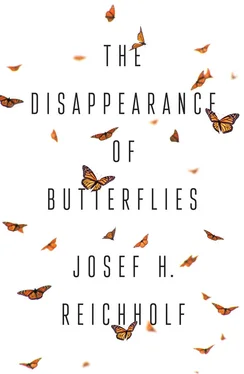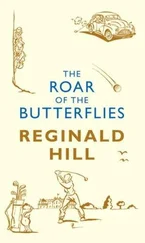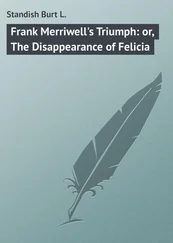1 ...6 7 8 10 11 12 ...15 In the spring, the rising temperature of the pond water allows the plants to grow new shoots and leaves. This onset of growth evidently signals to the caterpillars that it is time to become active once more. They leave their cavities, crawl upwards and feed on the tender new leaves. This provides them with the wax necessary for their transformation into the water-repelling condition. By May, the only caterpillars will be those in air-filled leaf cases, feeding hungrily on new floating leaves until they are fully grown and ready for pupation. The moths that hatch from those pupae make up the first generation. Their descendants will continue to develop, without the need for a hibernation period. With these two reproductive cycles, the year of the ‘little nymph’, Nymphula , is complete.
The advantages of living in water
My dissertation also dealt with the details of the skin structure and its changes during the period when the caterpillar stops breathing through its skin and starts to breathe oxygen using the system of trachea that is typical of insects. This required imaging with an electron microscope, which the University of Munich was able to arrange. But what was truly exciting for me was – and remains – the lives of these moths with their adaptations to the water plants that sustain them and their life in the water. Why did they come to inhabit this environment? What advantages does it offer them?
The discovery that would be of greatest importance in addressing this issue did not even occur to me at first: nearly all my attempts to breed caterpillars were successful and produced moths. Indeed, nothing could happen to them in my small aquarium, except perhaps damage through my own carelessness. All the pupae that I collected outdoors (together with their underwater leaf cases) in order to watch the emergence process emerged successfully. Without giving it any thought, I assumed that all the caterpillars in their various stages that I had collected for my research would continue to develop without any problems, pupate and produce moths. The penny only dropped, as the saying goes, years later, when I had already become involved with a quite different type of species, the small ermine moth. There is a separate chapter devoted to them. Through them, the advantage of life in the water became suddenly apparent: I had had no losses, because the caterpillars and pupae of my aquatic moths had not been attacked by parasites. For practically all the butterflies and moths that live on dry land, parasites are among the main factors that determine their abundance and their development from one stage to the next. With around 96–98 per cent of 694 caterpillars from several breeding groups, the hatching success of my aquatic moths was phenomenally high. I only recorded higher losses for the eggs. I did not discover who or what caused the losses under outdoor conditions, but I considered the egg-eating water mites and the rotting sludge build-up in the heavily silted pools to be the likely causes. With 100 or more eggs per clutch and per female moth, such losses prevent the caterpillars from consuming all the available floating leaves too soon, which can easily happen where brown china-marks exist in large numbers.
This was why the gardeners in the Botanical Gardens in Munich placed their hopes in my research into the aquatic moths when I first encountered the little nymphs. Over the following years and decades, I definitively established that the female brown china-mark will leave the pool from which she emerged if the floating leaves of the water plants have been overconsumed. She will examine the edges of the floating leaves quite thoroughly before laying her eggs, and for good reason. If there is extensive feeding damage, she will leave and search for other waters with better conditions. A tendency to disperse would already be expected, since such small bodies of water are normally only temporary. Under natural conditions, they arise through inundation of the floodplains. New ponds will last a couple of years or a few decades, depending on how large or small they are when they form, and gradually disappear again through sedimentation and plant succession. Species that colonize an environment that is by its nature unstable must seek alternatives in good time.
The dispersal behaviour of the aquatic moths is therefore very particular. As insects, they probably belong to the group of pioneering species that is familiar to us through many land-based plants and that quickly colonizes newly created environments. On the other hand, maybe we are dealing with specialists that need a specific, longer-lasting ‘life zone’: that of floating leaves at the edges of large bodies of still water. Closer to the centre of the body of water there are plants that grow entirely under water, described by specialists as ‘submerged’. The moths seek out shore plants that stand in the water but protrude above it, away from the centre of the pool. These are plants that are ‘emerged’ (in the ecological sense). In order to understand my aquatic moth and to be able to place it properly among its relatives, I would need to deal with the environment of small waterbodies and shores in far greater detail. Was it a pioneer species or was it specially adapted to the specific environment of bodies of water?
A place to live or an ‘ecological niche’
The gravel pits combined all the conditions of the larger waterbodies in a small space. Accordingly, in most of them, I was also able to find the various other species of aquatic moth that exist in central Europe. They form an almost exemplary ‘ecological series’, feeding variously on the shore (or ‘emergent’) plants, through the floating leaves and all the way down to the submerged water plants. This sequence of adaptation is visible in the moths themselves. The caterpillars of the beautiful china-mark, Nymphula stagnata ( nitidulata ) *feed on bur reed, Sparganium sp. and other species of plant that project out of the water near the bank. Moving out into the water, to the zone where plants with floating leaves grow, is ‘my’ Nymphula nymphaeata. The series continues under water with the ringed china-mark, Paraponyx stratiotata , and the most unusual of all, Acentropus niveus. In side pools, provided they are covered with duckweed, you will also find the small china-mark, Cataclysta lemnata. All these species live next to one another, in the strictest sense of the word, in adjacent ecological niches. All have special adaptations that, in the extreme case of the water veneer, Acentropus niveus ( Acentria ephemerella ), with its two forms of female, have even led to a permanent life in the water. More about this shortly. First, the bigger picture must be understood. It shows the diversification of moths belonging to the small moth family, the Crambidae, known to be extraordinarily adaptable, from the bank right out into the water. The further they have advanced, the more abundant they are.
The abundance of a species is, in a general sense, an indication of its biological success. The caterpillars of Nymphula stagnata live to a greater or lesser degree on the banks, above the water surface. They are the rarest species in our series. Cataclysta lemnata , whose caterpillars use the small leaves of the duckweed plant to construct their cocoons and for nutrition, usually becomes considerably more common as one moves towards the centre of the body of water, but its occurrence is limited to small waterbodies that are carpeted in duckweed plants, which are also known as ‘water lentil’, or Lemna . The occurrence of my little nymph, Nymphula nymphaeata , is much more widespread and frequent. In order to build their leaf cases, its caterpillars cut out a pair of oval leaf sections, up to 3 centimetres in length. This can be readily seen from land.
Читать дальше












